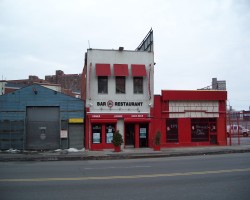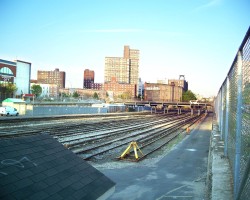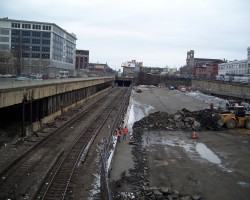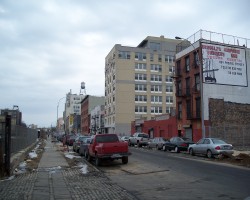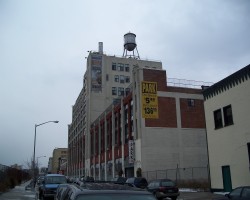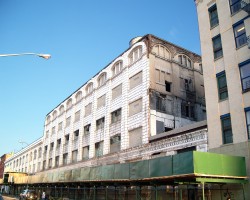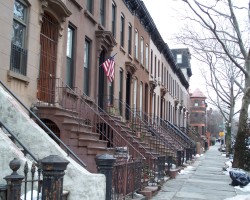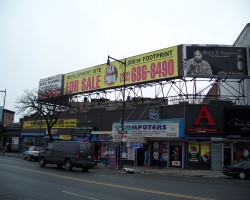Atlantic Yards
The following are photos of the area that beame Atlantic Yards, a Brooklyn real estate project over and around the Long Island Railroad's Vanderbilt rail yards. Development included a new arena for the Nets professional basketball team, office/retail space, and 6,400 residential units in 17 massive buildings. The site is near Downtown Brooklyn and is adjacent to the neighborhoods of Prospect Heights, Park Slope, and Fort Greene.

On February 22, 2007 I ventured to the site with the received memory of Robert Moses' abhorrent 20th century urban renewal projects foremost in my consciousness. I expected to find a ill-fated blocks of noble, unappreciated buildings destined for destruction by a heartless billionaire.
What I found was a much more complex vestigial remnant of New York's industrial past in transition to a residential future. I still have significant sympathy with the local residents who strongly oppose the seizure of their property and the radical transformation of their neighborhood. I still feel that smaller-scaled natural development of this area would produce a smoother transformation and more satisfying outcome. However, after walking among the numerous decrepit buildings and unsuccessfully dodging the numerous piles of dog excrement left by the pets of uncaring local owners, I must admit that the new development will certainly be cleaner.
Developer: Atlantic Yards is being spearheaded by the Forest City Ratner Companies, which was established in 1985 by the appropriately-named developer Bruce C. Ratner as an affiliate of Forest City Enterprises, a publicly-traded Cleveland-based real estate development company established in 1921. Ratner's Brooklyn developments include One Pierrepont Plaza (opened 1988), MetroTech Center, The Atlantic Center Mall (opened 1996) and Atlantic Terminal Office and Retail Complex (opened 2004). Forest City Ratner also owns the Queens Center Mall and Embassy Suites in Manhattan.
History: As America suburbanized following World War II, this area fell into decline and became a magnet for oversized, grandiose redevelopment plans typical of an era that saw destruction of the old as a virtue. ( history link)
- In 1954 the LIRR terminal on the northeast corner of Atlantic and Flatbush was eyed for a new Brooklyn Dodgers stadium, although the idea was nixed by city planning czar Robert Moses (because the traffic would be awful) and ultimately led the Dodgers to move to Los Angeles in 1958.
- In 1962, the City Planning Commission unveiled the Atlantic Terminal Urban Renewal Area (ATURA), a plan that would have leveled much of the existing architecture for replacement with "modern" apartment buildings. Little became of ATURA until city-subsidized apartment buildings and smaller development projects began sprouting in the early- and mid-70s.
- In 1985, grand plans for a large complex of residential and office space for the area north of Atlantic Avenue were unveiled, but were restrained by community legal action.
- In 1990, the project was re-envisioned to include a mall (which opened in 1996) and the heavily subsidized Atlantic Terminal office and retail which opened in 2004.
- In 2004 Ratner unveiled the current plans for Atlantic Yards and the project was approved by the Public Authorities Control Board on December 20, 2006. However, legal efforts to stop the project continue even as construction is beginning.
Size Problems: The major arguments that have dogged numerous ideas for this site have revolved around plans that have simply been too large for the area.
- The gargantuan residential towers (on hideous asymmetrical designs by Frank Gehry) will look like cancerous growths in the context of the surrounding low-rise neighborhood. ( google earth picture).
- While there is an argument that a large commercial component is necessary to subsidize the construction of the arena, development size is usually more indicative of greed and ego than any larger concern for the community.
- The public transit infrastructure in the area is excellent, with an LIRR station and the intersection of many major subway lines. But the road infrastructure is not quite as robust and automobile traffic will completely swamp the area, especially during arena events.
- The planned public spaces will certainly not offer adequate outdoor recreational opportunities for the massive influx of population.
- Smaller redevelopment projects have been occurring in the area for years and have fit much more "organically" within the community than will this massive, disruptive effort.
- Rising rents in Manhattan have spurred a significant amount of redevelopment throughout the outer boroughs and the area would ultimately be redeveloped without the expenditure of $2 billion in public money and tax breaks.
Eminent Domain: While much of the Atlantic Yards property has been acquired through legitimate purchases, eminent domain will be required to oust the final holdouts. Since this is a private and, arguably, unnecessary project, there is a fundamental question about whether it is right for the government to take land from a small land owner and give it to a bigger land owner so he can make billions of dollars. Although the controversial 2005 ruling by the U.S. Supreme Court in Kelo v. City of New London does not bode well for the current plaintiffs trying to protect their homes, this is an emerging area in constitutional law and in politics that is not yet settled.

